Recent Articles
Popular Makes
Body Types
2024 Polestar 2 Road Test and Review
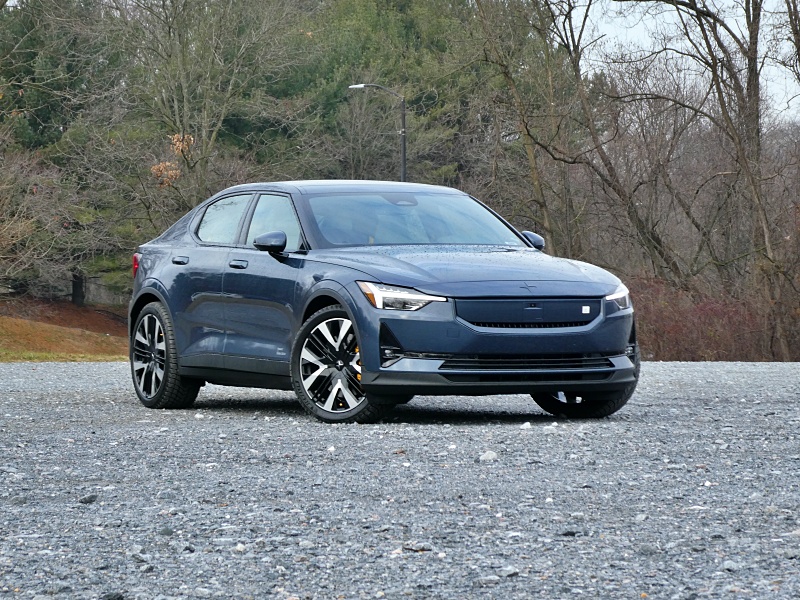
2024 Polestar 2 ・ Photo by Brady Holt
The Tesla Model 3 is America’s dominant electric sedan. It sells at 10 times the volume of its No. 2 rival (the BMW i4) and 20 times the volume of the car we’re reviewing here, the 2024 Polestar 2.
The Polestar 2 has been an odd duck since its debut as a 2021 model. It shares design details and mechanical components alike with its sister brand Volvo, but it’s not a Volvo. It looks like a chunky sedan, but it’s actually a five-door liftback. It’s wildly fast, but no faster than a Model 3 that costs much less and goes farther on a charge. Still, Polestar isn’t giving up. It has updated the 2 every year since its debut, with 2024 bringing the biggest changes yet – including the good stuff of more range, power, and standard features. We spent a week testing the 2024 Polestar 2, now priced from $49,900, to see what it brings to the EV sedan market. Keep reading to find out what we learned and whether this is the right electric car for you.
Much Longer Range
One of the first questions most folks have about any electric car is how far it can travel per charge. Nearly every current-model EV can travel much farther than most folks go in a typical day, and plugging them in at home overnight means they’re ready to go again in the morning. But range anxiety is real for road trips.
Fortunately, the Polestar 2 gets a much longer range this year. Most notably, the base two-wheel-drive model now travels an EPA-estimated 320 miles per charge (or 307 miles with 20-inch wheels instead of the standard 19-inchers). The all-wheel-drive model gets a boost, too, from 260 miles to 276 miles (or 266 miles with 20-inch wheels). The Performance Pack now cuts range to a disappointing 247 miles. However, our Performance Pack test vehicle was on track to beat that estimate despite chilly December temperatures – not the most favorable conditions for an electric car – during our weeklong test. Impressively, all Polestar 2s except the Performance Pack get more than 100 MPGe, the energy equivalent of gas mileage. And on a public fast charger, you can get from 10 percent to 80 percent in about half an hour.

2024 Polestar 2 ・ Photo by Brady Holt
More Speed, Too
High-end electric luxury cars are often about speed as much as efficiency, and Polestar understands this more than most. The base powertrain now uses its single motor to power the rear wheels instead of the front wheels, and it now makes 295 horsepower and 361 lb-ft of torque versus last year’s 228 hp and 243 lb-ft. Polestar says the single-motor 2 now needs a mere 5.9 seconds to reach 60 mph, which is already quicker than some sports cars.
All-wheel drive brings a second electric motor, cranking up output to 421 hp and 546 lb-ft of torque. The Polestar 2 Dual Motor reaches 60 mph in 4.3 seconds, while the 455-hp Performance Pack pulls off a 4.1-second sprint. These speeds match the latest Tesla Model 3 (though not the Tesla’s discontinued Performance model) and beat the BMW i4 and Hyundai Ioniq 6. The Polestar 2 also has a firmly tuned suspension that yields agile, responsive handling. The ride gets quite abrupt on the Performance Pack, though never clompy and unrefined. Owners can also ask a dealership to retune the Performance Pack’s shocks for a stiffer or gentler ride.
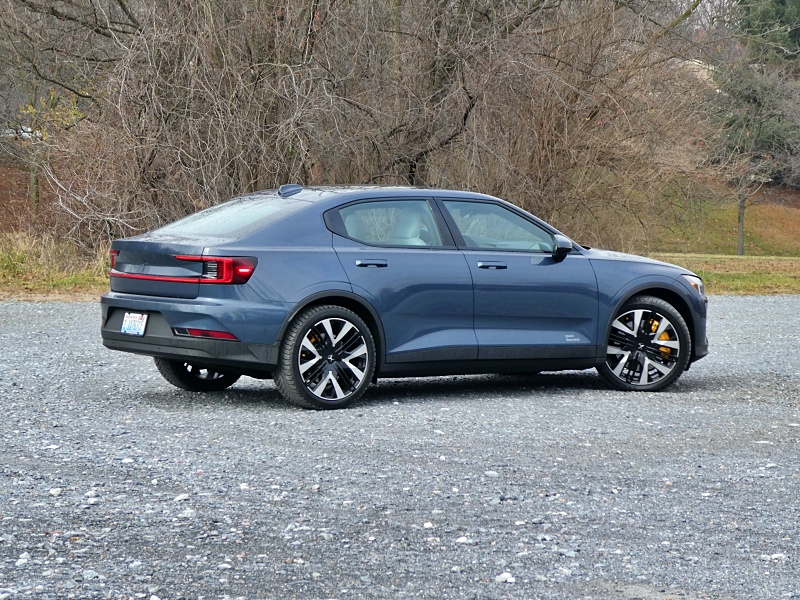
2024 Polestar 2 ・ Photo by Brady Holt
No More Grille
The speedy Polestar 2 is a sleeper car – not one that telegraphs its high-speed abilities. Stubby and blocky, with a high body above its big wheels, it looks almost like an SUV sedan. The headlights include Volvo’s “Thor’s hammer” spear pointing toward a grille that, in the Polestar’s case, is now a smooth piece of plastic. (The company dropped its pretense of a grille this year, tacitly acknowledging that there’s no engine to cool.) Upcoming Polestar models will be sleeker and look less like Volvos.
Around the back, you’d never guess that the Polestar 2 is a hatchback rather than a traditional sedan. A conventional-looking trunk sticks out more distinctly than in a Tesla Model 3, which is a sedan. But the Polestar’s rear windshield glass lifts up with the metal for more cargo space and flexibility, which we’ll discuss more later.
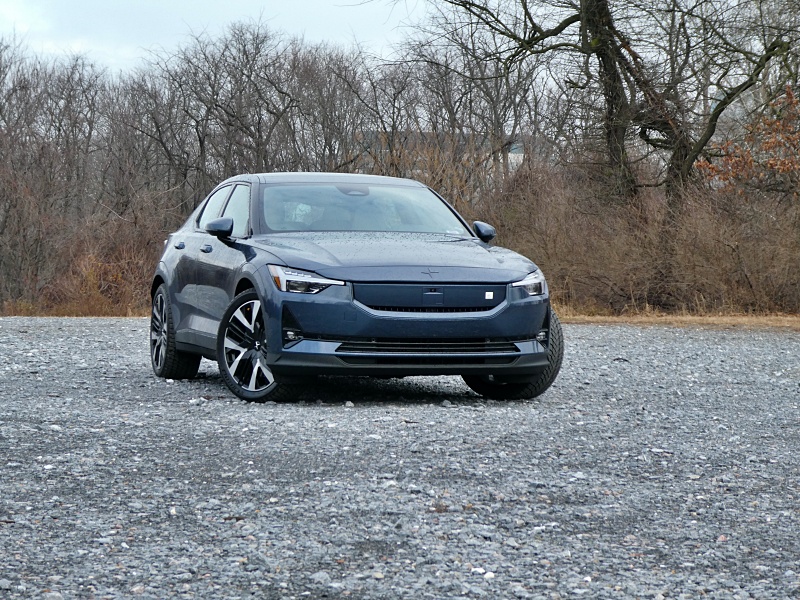
2024 Polestar 2 ・ Photo by Brady Holt
Upscale Interior
The Polestar 2 also has a Volvo vibe inside, and in many ways, that’s a good thing. It means the Polestar has luxury-grade interior quality – rich materials, parts that move slickly, and well-assembled panels. On the tech front, there’s a Google-based 11.2-inch infotainment touchscreen plus a 12.3-inch digital gauge cluster that can also include a Google Maps view.
The Polestar lands in a middle ground between a conventional sedan and an aggressively tech-focused electric car. Digital screens don’t dominate the entire dashboard like a Tesla, but nor are there lots of physical buttons and knobs. On the other hand, Polestar doesn’t reinvent basic functions like turn signals, a speedometer, or headlight controls. And the car doesn’t try to guess whether you’re trying to drive forward or backward. Also, in addition to built-in Google Maps, the Polestar supports Apple CarPlay (though not Android Auto) smartphone integration.
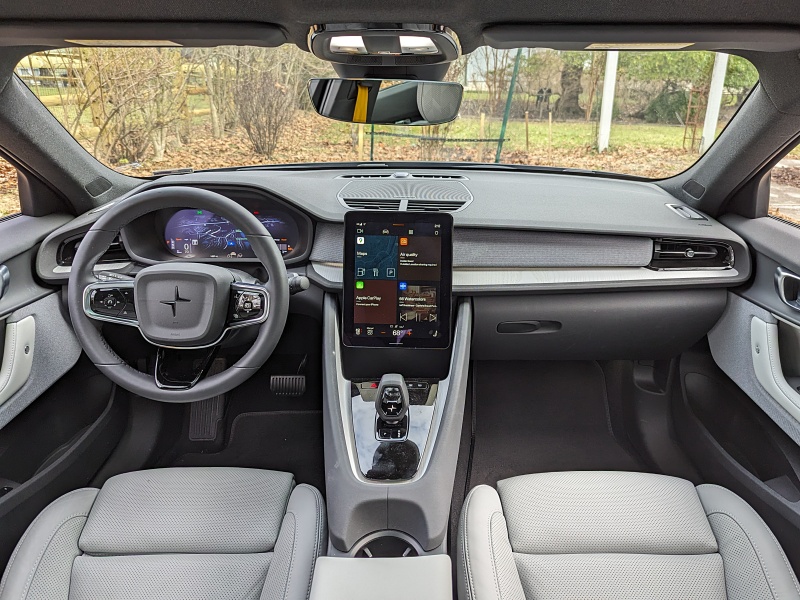
2024 Polestar 2 ・ Photo by Brady Holt
Comfortable Seating
Volvos are known for very comfortable seats, and the Polestar 2 continues that tradition. The front seats are well-shaped and supportive for long-distance comfort. Our main complaint is that some folks will find them too narrow, particularly given the Polestar’s wide center console.
The Polestar’s backseat is decently roomy for a compact luxury sports sedan. That means adults will fit but won’t be able to stretch out and relax. The Tesla Model 3 has more room. Cloth upholstery is standard, which surprises us at this price point. We appreciate the chance to get a high-end vehicle without leather or leatherette, but some customers will think Polestar is short-changing them. Heated front seats are standard, and ventilated front seats are part of a $4,000 package that includes leather upholstery. A heated steering wheel and heated rear seats are also available as options.
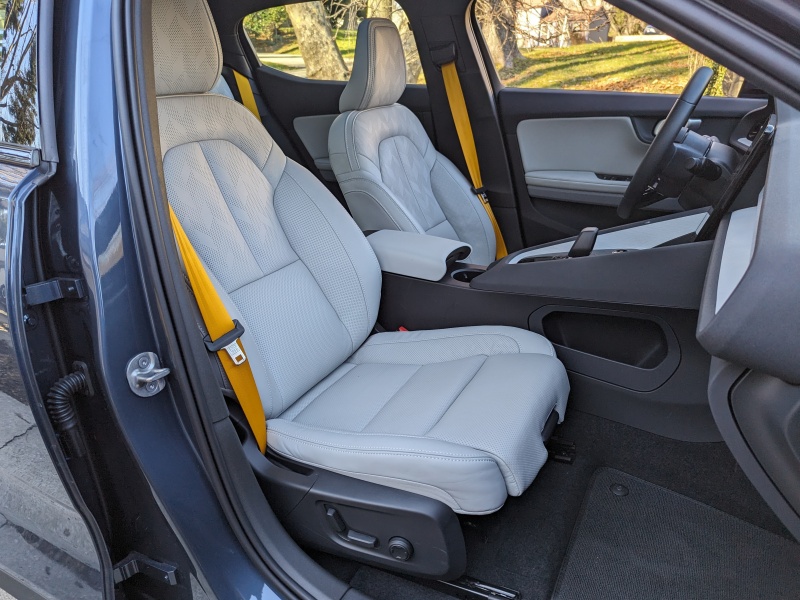
2024 Polestar 2 ・ Photo by Brady Holt
Flexible Cargo Hold
As we mentioned, the Polestar 2 is a five-door liftback rather than a conventional sedan. That's not a thrilling technological breakthrough; this body style is nothing new, particularly among European vehicles. (The rival BMW i4 is also a liftback.) But it’s a valuable advantage over a Tesla Model 3.
The Tesla claims a massive 21-cubic-foot trunk versus the Polestar’s modest 14 cubic feet behind the rear seat. However, our impression is that there’s a smaller gap in the real world. And because the Polestar is a liftback rather than a sedan, you can fold down its seats and remove its rigid cargo cover to open up 38 cubic feet of total cargo space. That’s much better than just passing a few long items through the Model 3’s trunk pass-through. Unlike some EVs, the Polestar has a front trunk (“frunk”) under its hood, but it measures a modest 1.4 cubic feet. That’s about half the Tesla’s volume; it’s a good place for a spare charging cable or a duffel bag, but not much else. The Polestar also has some hidden storage space under the cargo floor that could hold another small bag. And you can prop up a panel to keep smaller items like grocery bags from sliding around.
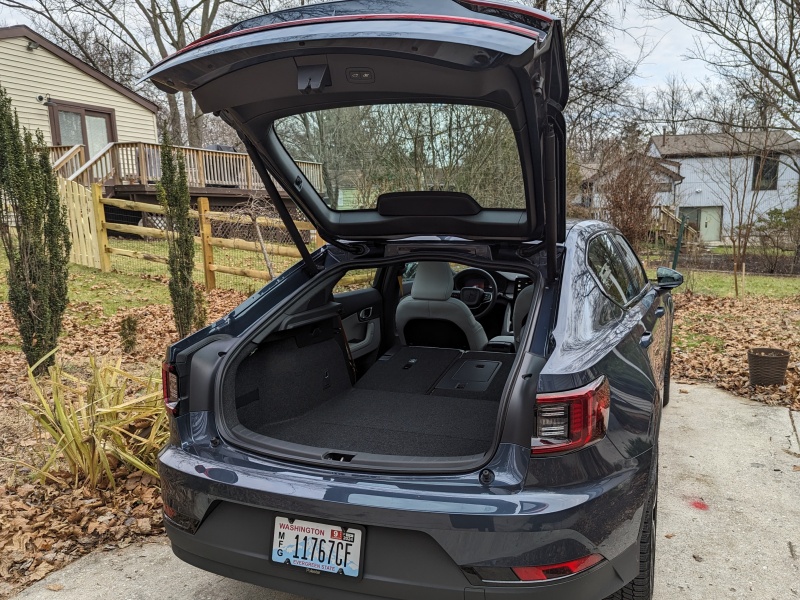
2024 Polestar 2 ・ Photo by Brady Holt
Value May Vary
When Polestar first hit the U.S. market, it was eligible for a $7,500 federal tax credit for plug-in vehicles. Then new policies mandated U.S. manufacturing and parts sourcing, which excluded the Chinese-built Polestar. (Volvo and Polestar are both Swedish companies owned by Chinese automaker Geely.) That means the Polestar’s $49,900 base price is on the high side, particularly if you start adding features like leather upholstery, adaptive cruise control, or a sunroof.
The Dual Motor model, with more power and all-wheel drive, starts at $55,300. And the Performance Pack, included on our Dual Motor test vehicle, costs another $5,500. Addding $1,250 for metallic paint and a $1,400 destination charge, our fully loaded vehicle wore a steep sticker price of $69,650. As we write, though, Polestar provides a $7,500 customer rebate to offset the missing tax credit — that’s a big discount even on a luxury vehicle. It makes the Polestar’s prices more appealing, especially without the expensive Performance Pack.

2024 Polestar 2 ・ Photo by Brady Holt
Competitors to Consider
The Polestar 2 faces three close competitors: the Tesla Model 3, the best-selling electric sedan; the BMW i4, a similar luxury-EV liftback; and the Hyundai Ioniq 6, a sleek, spacious, and comfortable electric sedan that has also sold well.
We’ve mentioned comparisons to the Model 3 at various times. It costs nearly $20,000 less after federal tax incentives (and still more than $10,000 less after the Polestar’s current discount), has longer ranges per charge with equivalently wild acceleration, and has a bigger back seat and frunk. And the latest 2024-model update has smoothed out the Tesla’s stiff ride. On the other hand, the Polestar has a more conventionally luxurious interior, more conventionally simple controls, and a more flexible cargo hold. Versus the BMW i4, the Polestar costs a bit less (even before the current rebate), accelerates a bit faster, and (depending on the trim level) goes farther on a charge. The BMW has more high-end luxury pizzazz and technological dazzle, though, and we found its infotainment system easier to use. Lastly, the Hyundai Ioniq 6 is roomy, stylish, and supremely competent, but it lacks sports-sedan moves and an extra-luxurious dashboard. And like the Tesla, it has a traditional trunk.

2023 BMW i4 ・ Photo by BMW
Final Thoughts
Under familiar skin, the 2024 Polestar 2 is a great leap forward, improving range without compromising its performance. It’s a better value than the BMW i4, it’s a better sports sedan than a Hyundai Ioniq 6, and it has less of a learning curve than a Tesla Model 3.
A boxy, electric, still fairly expensive sports sedan still falls into a pretty narrow niche. But the 2024 Polestar 2 fills it more ably than ever, particularly if you can score one for $7,500 off.
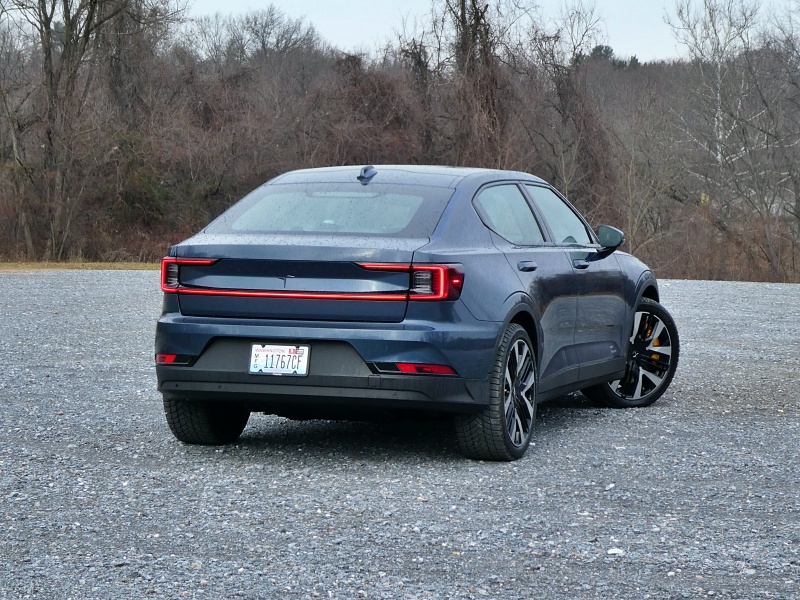
2024 Polestar 2 ・ Photo by Brady Holt